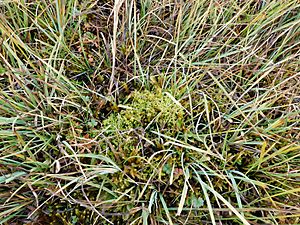Three-ranked hump-moss facts for kids
Quick facts for kids Three-ranked hump-moss |
|
|---|---|
 |
|
| Conservation status | |
| Scientific classification | |
| Genus: |
Meesia
|
| Species: |
triquetra
|
The Three-ranked hump-moss (Meesia triquetra) is a special type of moss. You can find it all over the northern parts of the world, in places far from the equator. It is known for its unique way of growing and its specific leaf shape.
Contents
What Does This Moss Look Like?
Meesia triquetra grows in small clumps or soft pads. These plants can often be quite large. They are acrocarpous, which means their spore-producing parts grow at the tip of the main stem. They are also dioicous, meaning male and female parts are on separate plants.
The moss is usually dark green to grass green on top. Sometimes, it can be reddish-brown underneath because of its thick root-like structures called rhizoids. The stems are mostly straight or have few branches. They are light brown to yellowish-brown and covered closely with leaves. These stems can grow from 2 to 14 centimeters tall.
Leaves and How They Grow
The leaves of this moss are very special. They are decurrent, meaning they extend down the stem a bit. When wet, they spread out widely, which is called squarrose. Their shape can be triangular, oval, or lance-shaped (like a spear tip). They are also a bit twisted (crispate). Each leaf is about 2 to 3.5 millimeters long.
One of the easiest ways to spot this moss is that its leaves grow in three clear rows. This is why it's called "three-ranked" (tristichous). The edges of the leaves are sharply toothed (serrate or denticulate) almost all the way to the bottom. They are usually flat, but sometimes they might curl back a little in the middle.
The main vein of the leaf, called the costa, is quite narrow. It runs almost to the tip or all the way through the leaf. The tip of the leaf is usually sharp or pointed (acute to acuminate). The leaf blade itself is only one cell thick (unistratose).
How This Moss Reproduces
The male parts of Meesia triquetra grow at the very end of the stems in flat, disk-shaped clusters (perigonia). The stalk that holds the spore capsule, called the seta, is straight and smooth. It is brown to yellowish-brown and very long, from 4 to 10 centimeters.
The spore capsule is not perfectly even; it's a bit lopsided and shaped like a pear (pyriform). It measures about 2.75 to 5.5 millimeters long, including its neck. The neck part, called the hypophysis, is long, making up about half of the capsule's length. It's clearly defined and doesn't wrinkle much when dry. The main part of the capsule, the urn, is oblong to short and cylinder-shaped. It's curved and uneven, brown to yellowish-brown, and up to 4 millimeters long. When dry, it looks wrinkled but not deeply grooved. The lid of the capsule, the operculum, is shaped like a short cone. The tiny hairs inside the capsule, called endostome cilia, are often well-developed. The spores themselves have tiny bumps on them (papillose).
How to Tell It Apart
You can easily recognize Meesia triquetra by its distinct three-ranked leaf arrangement and because it has separate male and female plants (dioicous).
It is different from a similar moss, M. uliginosa, in a few ways:
- M. triquetra has leaves that spread out widely (squarrose).
- Its leaf vein (costa) is narrow compared to the base of the leaf.
- Its leaf edges are toothed and flat.
- Its leaf tips are sharp.
In contrast, M. uliginosa has a wide leaf vein, smooth and rolled-back leaf edges, and blunt leaf tips. Other Meesia species also have blunt tips.
Where Does This Moss Live?
This moss is found all around the northern parts of the world. It lives in Northern Europe, northern Asia, Greenland, Canada, and the northern United States. Some reports also show it in Oceania.
Its Favorite Home: Wetlands
These mosses love wet places, especially in wet forests. They grow in the wettest parts of what are called "extreme rich fens." Fens are types of wetlands. "Extreme rich fens" have surface water with high pH (meaning it's not acidic) and lots of calcium. Scientists say this moss is a very good sign that you are in a rich fen. Other plants that often grow with it include Scorpidium species and Drepanocladus revolvens.
Fire and Fens
We don't know much about how fire affects this plant. However, fens rarely catch fire because they are so wet. If there's a lot of smoke from a nearby fire, it could harm the moss's home. In similar wet areas called conifer bogs, fires happen about once every 150 to 200 years. Fire can badly damage the peat (decayed plant material) in a bog. But for a bog to burn, it needs to be very dry, like during a drought. Usually, bogs are too wet to burn.
Protecting This Moss
The Three-ranked hump-moss is considered a sensitive species by the United States Forest Service in the Pacific Southwest Region. The California Native Plant Society lists it as a plant that needs to be watched.
NatureServe gives it a California State Rank of S2.2, which means it's very rare or at high risk in California. Its Global Rank is G5, meaning it's common and secure worldwide, but locally it can be in trouble.
Threats to Its Home
Fens are delicate places. They can be easily harmed by things like:
- Livestock grazing (animals eating plants).
- Changes to how water flows (hydrologic alteration).
- Building and using roads.
- Digging up peat (peat mining).
Rich fen habitats are especially easy to change. The chemistry of the water in rich fens is sensitive to changes in climate and human activities. Sadly, this moss has almost disappeared in Europe.


